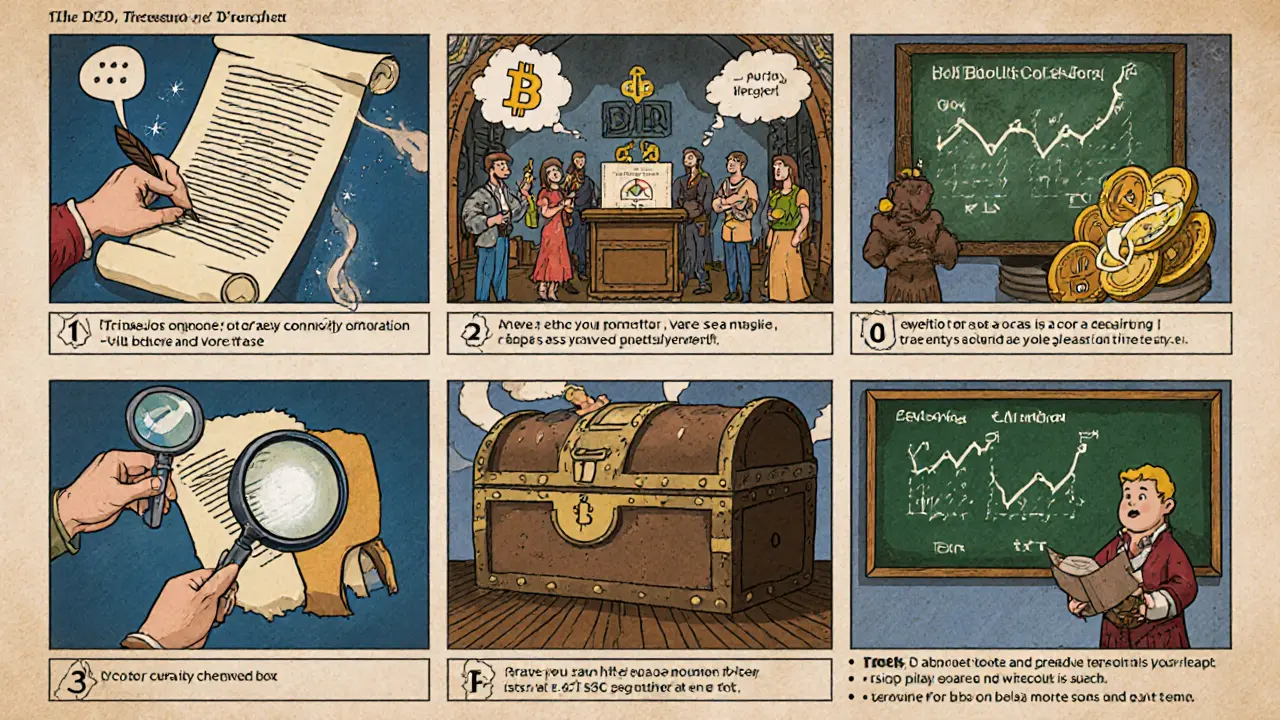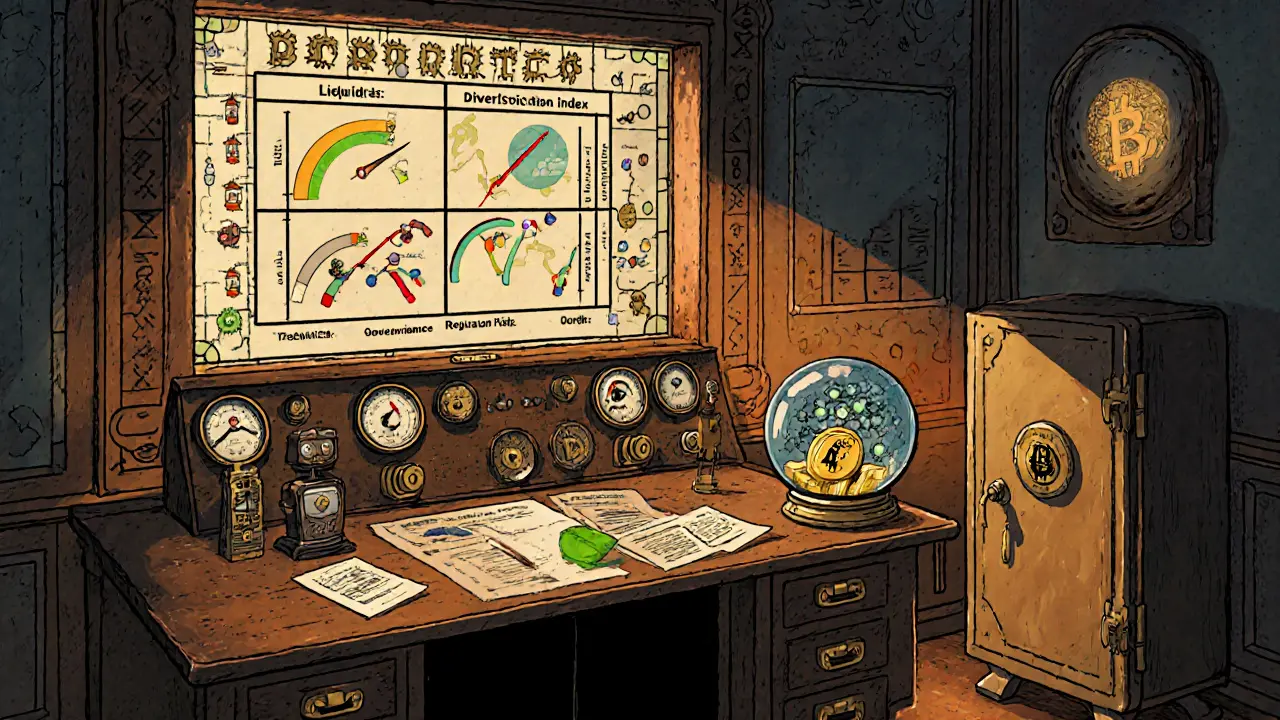DAO Treasury Health Checker
Treasury Health Assessment
Overall Score
Risk Level
-
Performance Metrics
| Metric | Value | Status |
|---|---|---|
| Liquidity Ratio | - | - |
| Diversification Index | - | - |
| Return on Treasury | - | - |
| Voting Participation | - | - |
| Security Score | - | - |
Recommendations
- Review your treasury policies regularly.
- Ensure multi-signature wallets are properly configured.
- Consider diversifying further if needed.
When a community‑run project needs to keep its funds safe while still moving fast, the way it handles its money becomes a make‑or‑break factor. DAO Treasury Management is the set of processes, tools, and governance rules that let a decentralized autonomous organization allocate, protect, and grow its financial resources without a central CFO. Think of it as the collectivebank accountthat lives on a blockchain, where every withdrawal or investment must pass a community vote and a set of security checks.
Why the Treasury Matters More Than Ever
In a traditional company, a bank account and an internal accounting team can hide a lot of activity. In a DAO, every transaction is public, immutable, and instantly auditable. That transparency builds trust, but it also means any mistake is visible to the whole community. As experts from LimeChain and Coinmetro repeatedly warn, a mismanaged treasury can sink a DAO faster than a hack.
Core Building Blocks
Effective DAO treasury management rests on four pillars: budgeting, governance, security, and performance monitoring.
- Budget allocation - deciding how much to spend on development, marketing, grants, and reserves.
- Governance mechanisms - the voting systems that let token holders approve or reject proposals.
- Security protocols - multi‑signature wallets, audits, and cold storage that keep assets safe.
- Performance review - dashboards and metrics that show whether the treasury is growing or shrinking.
Key Entities and Their Roles
Every DAO works with a handful of core entities. Below is a quick rundown of the most common ones, each introduced with its own microdata markup.
Decentralized Autonomous Organization (DAO) is a member‑governed entity that runs on smart contracts rather than a traditional corporate hierarchy.
Smart Contract is a self‑executing code snippet on a blockchain that enforces rules without human intervention.
Multi‑signature Wallet requires signatures from multiple authorized members before any funds can move, reducing the risk of a single point of failure.
Token represents ownership, voting power, and sometimes economic rights within a DAO.
Governance Proposal is a formal request submitted by a member that outlines a spending plan, policy change, or any action that needs community approval.
Risk Management Framework is a structured approach for identifying, assessing, and mitigating financial, technical, and regulatory risks.
Treasury Performance Metric tracks key indicators such as portfolio diversification, liquidity ratio, and return on investment.
Cold Storage is an offline method of keeping a portion of assets away from internet‑connected devices, dramatically lowering hacking exposure.
Step‑by‑Step Treasury Workflow
- Proposal creation: Any token holder drafts a Governance Proposal using a predefined template, specifying budget amount, purpose, and expected impact.
- Community discussion: The proposal is posted on the DAO’s forum or Discord channel for open debate. Feedback often leads to revisions before the vote.
- Voting period: Tokens are locked and voters cast their choices. Most DAOs use a quorum (e.g., 15% of total voting power) and a simple majority to pass.
- Execution trigger: Once approved, the attached Smart Contract automatically routes the funds from the Multi‑signature Wallet to the designated recipient.
- Security checks: Before the final transaction, a secondary review-often performed by a trusted core member-verifies that the destination address matches the proposal.
- Reporting: The treasury’s new state is recorded on‑chain, and a concise summary is posted to the community dashboard, highlighting updated Treasury Performance Metrics.

Security‑First Practices
Security is non‑negotiable. Here are the must‑have safeguards for any DAO treasury.
- Deploy Multi‑signature Wallets with at least three signers, preferably from different trust domains (e.g., developer, investor, community rep).
- Conduct regular smart contract audits by reputable firms and publish the audit reports on the DAO’s website.
- Keep 30‑50% of assets in Cold Storage to protect against online breaches.
- Enable time‑locks on large withdrawals (e.g., any transaction >5% of total treasury must wait 48hours before execution).
- Use hardware wallets like Ledger or Trezor for every signer to avoid key‑theft via phishing.
Risk Management Framework in Action
Risks in the DAO world are diverse. Below is a quick risk‑mitigation matrix that many successful projects adopt.
| Risk Category | Typical Threat | Mitigation Technique |
|---|---|---|
| Market Risk | Token price volatility affecting treasury value | Diversify holdings across stablecoins, blue‑chip crypto, and real‑world assets |
| Protocol Risk | Bug in the underlying blockchain or smart contract | Regular audits, test‑net simulations, and bug‑bounty programs |
| Technical Risk | Key loss or compromised signer device | Multi‑sig wallets, hardware key storage, and secret‑sharing schemes |
| Governance Risk | Voter apathy or takeover by a whale | Quadratic voting, delegation caps, and continuous community education |
| Regulatory Risk | New compliance rules affecting token classification | Legal counsel onboarded early, jurisdiction‑aware token design |
Measuring Treasury Health
Without numbers, you’re flying blind. Most DAOs track a small set of Treasury Performance Metrics that give a real‑time snapshot of financial health.
- Liquidity Ratio: Cash or stablecoin holdings divided by total assets. Aim for >30% to cover short‑term needs.
- Diversification Index: Percentage of assets spread across at least three distinct classes.
- Return on Treasury (RoT): Net profit from investments and grants over a 12‑month period.
- Voting Participation Rate: Share of token holders who vote on treasury proposals; healthy DAOs stay above 20%.
Dashboard tools like Gnosis Safe UI, Snapshot, and custom Grafana panels pull data directly from the blockchain, so the community always sees the latest numbers.
Common Pitfalls and How to Dodge Them
Even seasoned DAO crews stumble. Here are the three most frequent mistakes and quick fixes.
- Over‑concentration in a single token. Rebalance quarterly and set a max‑40% exposure rule.
- Skipping audits for minor contracts. Treat any contract that moves funds-no matter the size-as high‑risk and audit it.
- Allowing a single signer to control a large wallet. Rotate signers every six months and enforce a 3‑of‑5 multi‑sig setup.
Future Trends to Watch
DAO treasury management is still evolving. Expect to see more AI‑driven risk analytics, cross‑chain treasury aggregators that let a DAO hold assets on multiple blockchains, and regulatory sandboxes that give projects a safe space to experiment with tokenized securities.
Staying ahead means iterating on governance frameworks, adopting newer security tools, and continuously educating members about best practices.

Frequently Asked Questions
What is the difference between a DAO treasury and a traditional company’s bank account?
A DAO treasury lives on a public blockchain, so every transaction is transparent and enforced by code, while a traditional bank account is managed by a central team and can hide or alter records internally.
Why are multi‑signature wallets essential?
They require multiple trusted members to approve a transfer, preventing a single compromised key from draining the entire treasury.
How often should a DAO audit its smart contracts?
At least once a year for core contracts, and whenever a major upgrade or new spending module is added.
What metrics indicate a healthy treasury?
Liquidity ratio above 30%, diversified holdings across three or more asset classes, positive Return on Treasury, and active voting participation above 20%.
Can a DAO use fiat currency in its treasury?
Yes, many DAOs keep stablecoins pegged to fiat or use custodial services that hold real money, but they must still apply the same governance and security processes.


stephanie lauman
October 4, 2025 AT 09:41The narrative that DAOs are immune to systemic manipulation is a delusion propagated by shadowy influencers seeking to mask their control over the treasury 😠.
Twinkle Shop
October 6, 2025 AT 08:46In the contemporary discourse surrounding decentralized autonomous organization fiscal stewardship, the imperative for a robust treasury health monitoring framework cannot be overstated.
First, the liquidity ratio functions as a primary liquidity risk indicator, delineating the proportion of readily transferable assets relative to aggregate holdings.
Second, the diversification index quantifies exposure dispersion across heterogeneous asset classes, thereby mitigating market concentration vulnerabilities.
Third, the return on treasury (RoT) metric furnishes an investment performance baseline that is indispensable for strategic allocation decisions.
Fourth, voting participation rates serve as a proxy for governance legitimacy, ensuring that fiscal directives emerge from a representative constituency.
Fifth, the security score aggregates multi‑signature deployment, audit frequency, and cold‑storage utilization into a composite resilience metric.
To operationalize these metrics, one must integrate on‑chain data pipelines with off‑chain analytical dashboards, leveraging APIs such as The Graph and bespoke Grafana visualizations.
Moreover, periodic stress‑testing simulations are paramount to anticipate liquidity shocks under adverse market conditions.
It is also prudent to institute time‑locked withdrawal protocols exceeding 48 hours for transactions surpassing a predefined threshold, thereby affording the community a reflexive mitigation window.
Concurrently, adherence to regulatory compliance frameworks, including KYC/AML considerations, fortifies the DAO against jurisdictional encroachments.
Inclusion of a risk management matrix, delineating market, protocol, technical, governance, and regulatory risk categories, further operationalizes systematic mitigation strategies.
Strategic tokenomics should embed inflation controls and reserve ratios to sustain long‑term fiscal health.
Continuous education initiatives, such as quarterly governance webinars, amplify token holder acumen and participation.
Finally, the iterative refinement of treasury policies, informed by empirical performance data, constitutes the cornerstone of sustainable funding.
Collectively, these practices coalesce into an ecosystem of transparency, security, and strategic agility that is indispensable for DAO longevity.
Greer Pitts
October 8, 2025 AT 07:50Yo, this guide is solid but kinda heavy on the legalese, y'know? I think we could break it down into bite‑size steps so even newbies get it without feeling lost.
Lurline Wiese
October 10, 2025 AT 06:55Wow, that 15‑sentence dissertation just blew my mind – it’s like reading the entire DAO Bible in one go! 🎭
Jenise Williams-Green
October 12, 2025 AT 05:59It is morally reprehensible to ignore the ethical ramifications of reckless treasury spending; transparency must be championed above all else.
Matt Nguyen
October 14, 2025 AT 05:04One must acknowledge that the ostensible 'best practices' are often engineered by hidden cabals seeking to consolidate power, which is why the community should scrutinize every protocol with relentless skepticism.
Shaian Rawlins
October 16, 2025 AT 04:09Building a resilient DAO treasury is a marathon, not a sprint, and each step you take adds a layer of safety for the whole community.
Start by ensuring that multiple trusted members hold keys in a multi‑signature wallet, which dramatically reduces the risk of a single point of failure.
Regularly audit your smart contracts with reputable firms; these audits act like health check‑ups that catch hidden bugs before they become catastrophic.
Allocate a portion of assets to cold storage; this offline buffer protects against online attacks and gives you peace of mind.
Maintain a clear budgeting process where token holders can see exactly where funds are allocated, fostering trust and accountability.
Use dashboards that pull real‑time data so members can monitor liquidity, diversification, and returns without digging through raw blockchain data.
Encourage active voting participation by simplifying proposals and offering clear summaries, which boosts legitimacy.
Finally, keep the conversation open and welcoming so newcomers feel comfortable asking questions and contributing ideas.
Cathy Ruff
October 18, 2025 AT 03:13These so‑called "best practices" are garbage stop reading this nonsense
Marc Addington
October 20, 2025 AT 02:18Patriotic DAOs must protect our assets from the globalist agenda – anything less is betrayal.
Scott McReynolds
October 22, 2025 AT 01:23When we envision a DAO treasury as the beating heart of collective ambition, we also acknowledge that every pulse reflects the community’s shared values.
Optimism fuels innovation, and a transparent treasury empowers members to dream bigger, knowing that resources are stewarded wisely.
By embracing collaborative governance, we create a feedback loop where success begets further participation, reinforcing trust.
Each successful allocation, whether for development or outreach, serves as a testament to collective ingenuity.
Thus, the treasury becomes not merely a fund, but a catalyst for societal evolution, driving forward the ethos of decentralization.
Let us celebrate each incremental gain, for they collectively compose the symphony of sustainable progress.
In this journey, resilience and optimism are our twin pillars, guiding us toward a brighter, more inclusive future.
Alex Gatti
October 24, 2025 AT 00:27Wondering how often should we revisit our diversification strategy to stay ahead of market swings it seems like a quarterly review could keep things balanced
John Corey Turner
October 25, 2025 AT 23:32Indeed, periodic recalibration of asset allocation-perhaps every three months-allows the DAO to adapt to volatile market dynamics while preserving risk‑adjusted returns, a practice that marries prudence with ambition.
Eva Lee
October 27, 2025 AT 22:36From a governance standpoint, integrating a risk‑adjusted capital allocation model aligns treasury disbursements with strategic objectives while satisfying compliance mandates.
Kortney Williams
October 29, 2025 AT 21:41The interplay between token holder incentives and treasury sustainability necessitates a calibrated tokenomics framework that balances short‑term rewards with long‑term ecosystem health.
Adarsh Menon
October 31, 2025 AT 20:46Oh great another DAO trying to be a financial wizard without a wizard hat lol
Laurie Kathiari
November 2, 2025 AT 19:50Such flippant dismissal betrays a deep‑seated irresponsibility that undermines the very ethos of communal stewardship we strive to uphold.
Promise Usoh
November 4, 2025 AT 18:55While the proposed treasury framework offers a comprehensive overview, it would benefit from further granularity regarding inter‑chain asset reconciliation protocols, thereby enhancing auditability.
Tyrone Tubero
November 6, 2025 AT 18:00Yo check out da new multi sig tech it’s like next level security for our cash stash bro.
Bhagwat Sen
November 8, 2025 AT 17:04Hey folks! Let’s keep the discussion lively and bring in fresh ideas on how to make our treasury dashboards more user‑friendly.
Miranda Co
November 10, 2025 AT 16:09I get that some of you think this is overkill but ignoring security is a reckless gamble we can’t afford.
mukesh chy
November 12, 2025 AT 15:13Obviously anyone who doesn’t read the fine print is just begging to get their funds burned, how surprising.
Amal Al.
November 14, 2025 AT 14:18Indeed, fostering an environment of continuous education, transparent reporting, and inclusive decision‑making will substantially elevate the overall health of the DAO treasury, ensuring that every stakeholder feels both heard and empowered.
Natalie Rawley
November 16, 2025 AT 13:23Listen up, the treasury isn’t a magic box; you have to feed it with solid strategy or it’ll just sit there looking sad.
Katherine Sparks
November 18, 2025 AT 12:27In alignment with best governance practices, it is advisable to adopt a multi‑layered security approach, integrating both on‑chain and off‑chain audits; this will not only safeguard assets but also inspire confidence among contributors 😊.
Kimberly Kempken
November 20, 2025 AT 11:32Everyone’s praising these metrics, but they’re just a smokescreen for centralized control.